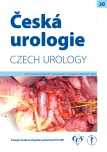INCIDENCE AND TREATMENT OF UROLOGICAL COMPLICATIONS AFTER TOTAL PELVIC EXENTERATION FOR ADVANCED PELVIC TUMORS
Authors:
Jaroslav Jarabák 1; Roman Zachoval 1; Vladimír Visokai 2; Jaromír Šimša 2; Ludmila Lipská 2; Miroslav Levý 2
Authors‘ workplace:
Urologické oddělení, Thomayerova nemocnice, Praha
1; Chirurgická klinika 1. lékařské fakulty Univerzity Karlovy a Thomayerovy nemocnice, Praha
2
Published in:
Ces Urol 2016; 20(1): 39-47
Category:
Original Articles
Overview
Major statement:
Total pelvic exenteration is an extensive performance with a high incidence of urological complications. The acute solution is urinary nephrostomy and once the patient is in remission then proceeding to stent or reanastomosis. The aim: To evaluate the incidence of urological complications in patients after total pelvic exenteration for advanced tumors of the small pelvis.
Material and methods:
Retrospective evaluation of patients who underwent a total pelvic exenteration in our hospital in 1999–2013. We evaluated: oncologic characteristics of the initial tumor, previous operations, neoadjuvant therapy, previous urological disease and related surgery, length of surgery, blood loss, type and duration of urological complications and their solutions.
Results:
A total of 42 patients, 28 men (67 %) and 14 women (33 %), average age 58 years (range 43–71). Urinary diversion was performed in 41 patients by ureteroileostomy, in one case by skin ureterostomy. Urological complications were detected in 12 patients (29 %), in four early and late in eight patients. Early complications included three patients with urinary leakage from the ureteroileoanastomosis, in one patient sepsis proven by an isolated urinary tract infection. Late complications were found, on average 24 months after surgery (range 4–60 months). Seven patients formed ureteric stricture in ureteroilealanastomosis. One patient experienced stricture of skin ureterostomy. The stage of cancer, previous surgeries, urological ailments, surgery length and amount of blood loss did not affect the incidence of complications. All patients with the occurrence of urological complications underwent neoadjuvant therapy.
Conclusion:
Urological complications after total pelvic exenteration occur in approximately one third of patients. Safe acute solution was to design a urinary diversion using a nephrostomy puncture. In patients with late complications at the 2.time replacement of nephrostomy for transureteral stent. Patients in long-term remission of cancer open revision with reanastomosis of the ureteroileal connection.
KEY WORDS:
Tumors of small pelvis, ureteral stricture, total pelvic exenteration, ureteroileostomy, urinary leakage.
Sources
1. Šimša J, Visokai V, Lipská L, Levý M. Pánevní exenterace v léčbě pokročilých nádorů malé pánve. Rohl. Chir 2014; 93(1): 34–37.
2. Brunschwig A. Complete excision of pelvic viscera for advanced carcinoma. A one-stage abdominoperineal operation with end colostomy and bilateral ureteral implantation into the colon above the colostomy. Cancer 1948; 1: 177−183.
3. Bricker EM. Bladder substitution after pelvic evisceration. Surg Clin North Am 1950; 30: 1511−1521.
4. Ferenschild FTJ, Vermaas M, Verhoef C, et al. Total pelvic exenteration for primary and recurrent malignancies. Word J Surg 2009; 33: 1502–1508.
5. Durgatosh P, Shuaib Z, Vikas M, Ravi K. Pelvix exenteration: a perspective from a regional cancer center in India. Indian J Cancer 2004; 41(3): 109–114.
6. Bladou F, Houvenaeghel G, Delpero JR, Guerinel G. Incidence and management of major urinary complications after pelvic exenteration for gynecological malignancies. J Surg Oncol 1995; 58(2): 91–96.
7. Petruzziello A, Kondo W, Hatschback SN, et al. Surgical results of pelvic exenteration in treatment of gynecological cancer. W Jour Surg Oncol 2014; 12: 279–284.
8. Wydra D, Emerich J, Sawicki S, Ciach K, Marciniak A. Major complications following exenteration in cases of pelvic malignancy: a 10-year experience. World J Gastroenterol 2006; 12(7): 1115–1119.
9. Hafner GH, Herrera L, Petrelli NJ. Morbidity and mortality after pelvic exenteration for colorectal adenocarcinoma. Ann Surg 1992; 215(1): 63–67.
10. Pawlik TM, Skibber JM, Rodrigues-Bigas MA. Pelvic exenteration for advanced pelvic malignancies. Ann Surg Oncol 2006; 13(5): 612–623.
11. Jadon R, Pembroke CA, Hanna CL, et al. A systematic review of organ motion ang image-guided strategies in external beam radioterapy for cervical cancer. Cin Oncol 2014; 26: 185–196.
12. Seifert L. Die darm-siphonbalse. Arch Klin Chir 1935; 183: 569–574.
13. Mansson W, Lindstedt E. Elektrolyte disturbances after jejunal condiut urinary diversion. Scan J Urol Nephrol 1978; 12: 17−21.
14. Karsenty G, Moutardier V, Lelong B, et al. Long-term follow-up of continent urinary diversion after pelvic exenteration for gynecological malignancies. Gynecol Oncol 2005; 97: 524–528.
15. Chang HK, Lo KY, Chiang AS. Complications of urinary diversion after pelvic exenteration for gynecologycal malignancy. Int Urogynecol J pelvic Floor Dysfunct 2000; 11: 358–360.
16. Golda T, Biondo S, Kresisler E, et al. Follow-up of double-barreled wet colostomy after pelvic exenteration at a single institution. Dis Colon Rectum 2010; 53: 822–829.
Labels
Paediatric urologist Nephrology UrologyArticle was published in
Czech Urology

2016 Issue 1
Most read in this issue
- THE USE OF SHOCK WAVES IN THE TREATMENT OF ERECTILE DYSFUNCTION
- HORSESHOE KIDNEY TRAUMA
- 18-F CHOLINE PET CT IN PRIMARY DIAGNOSIS OF THE PROSTATE CANCER
- NEUROSTIMULATION AND NEUROMODULATION IN THE CHILDHOOD
